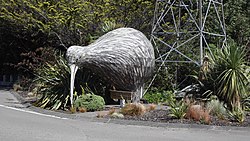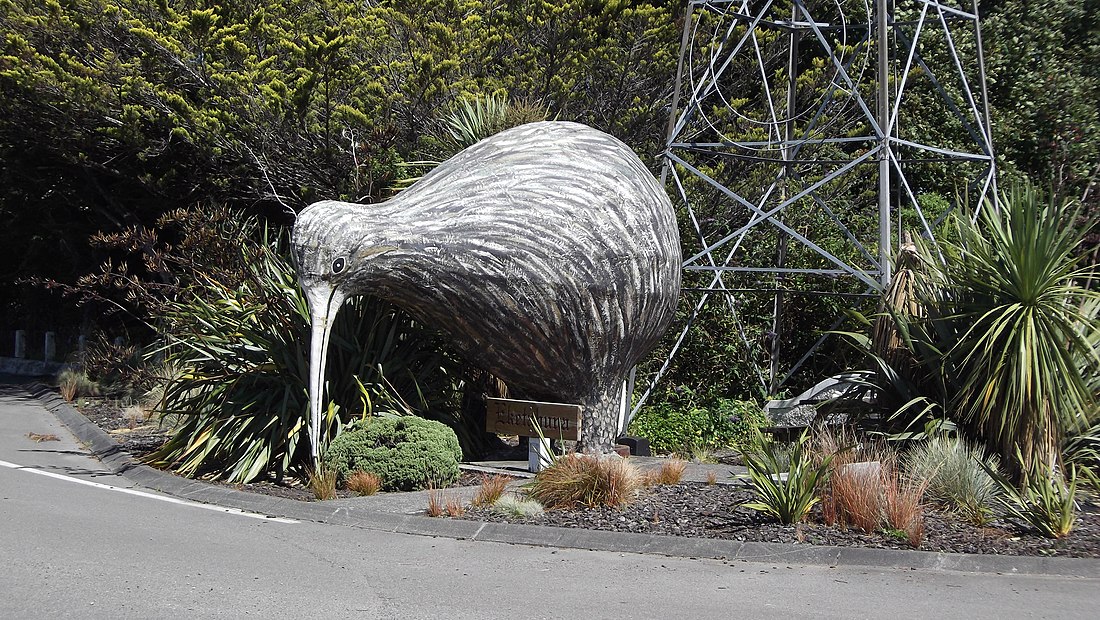Eketāhuna
Town in Manawatū-Whanganui, New Zealand From Wikipedia, the free encyclopedia
Eketāhuna is a small rural settlement, in the south of the Tararua District and the Manawatū-Whanganui region of New Zealand's North Island.
Eketāhuna | |
|---|---|
 Eketāhuna Kiwi | |
 | |
| Coordinates: 40.647°S 175.704°E | |
| Country | New Zealand |
| Region | Manawatū-Whanganui |
| Territorial authority | Tararua District |
| Ward |
|
| Community | Eketāhuna Community |
| Electorates | |
| Government | |
| • Territorial Authority | Tararua District Council |
| • Regional council | Horizons Regional Council |
| • Tararua Mayor | Tracey Collis |
| • Wairarapa MP | Mike Butterick |
| • Ikaroa-Rāwhiti MP | Cushla Tangaere-Manuel |
| Area | |
• Total | 4.18 km2 (1.61 sq mi) |
| Population (June 2024)[2] | |
• Total | 590 |
| • Density | 140/km2 (370/sq mi) |
| Time zone | UTC+12 (NZST) |
| • Summer (DST) | UTC+13 (NZDT) |
| Postcode | 4900 |
| Area code(s) | 06 |
The town is located at eastern foot of the Tararua Ranges, 35 kilometres north of Masterton and a similar distance south of Palmerston North. It is situated on State Highway 2, on the eastern bank of the Mākākahi River.[3]
Eketāhuna has become synonymous with stereotypes of remote rural New Zealand towns, with New Zealanders colloquially referring to the town in the same way other English speakers refer to Timbuktu.[4]
The New Zealand Ministry for Culture and Heritage gives a translation of "land on the sandbank" for Eketāhuna.[5] When pronounced in the typical Pākehā way, the name sounds like the Afrikaans sentence "I have a chicken" (Afrikaans: Ek het 'n hoender), making it amusing to immigrant Afrikaans-speaking South Africans in New Zealand.[6]
Geography
The corresponding Statistics New Zealand statistical area covers an area of 892.66 km².[7]
The Pukaha / Mount Bruce National Wildlife Centre is located to the south of the town.[6]
History

Early settlement
Eketāhuna was settled in 1872, under the name Mellemskov.[6] It was renamed soon after its founding.[8]
Modern history
The population of Eketāhuna and the wider area has plummeted in the 21st century, dropping from 1,920 in 1996 to just 630 in 2013.[9]
On 20 January 2014, the town was the epicentre of the 2014 Eketāhuna earthquake. Measuring 6.2 on the Richter magnitude scale, the quake caused moderate damage all over the southern North Island.[10]
In July 2020, the name of the town was officially gazetted as Eketāhuna by the New Zealand Geographic Board.[11]
Mayors
The Eketahuna Borough Council existed from 1907 until 1974 where it superseded by Eketahuna County Council which was later merged into Tararua District.
| Name | Term | |
|---|---|---|
| 1 | Alfred Henry Herbert | 1907-1909 |
| 2 | Edward Page | 1909-1912 |
| 3 | F.C. Turnor | 1912-1919 |
| 4 | T. Parsons | 1919-1921 |
| 5 | P. Pike | 1921-1923 |
| 6 | W. Simpson | 1923-1927 |
| 7 | T.M. Page | 1927-1929 |
| (6) | W. Simpson | 1929-1940 |
| 8 | W. Olsen | 1940-1944 |
| 9 | O. Walton | 1944-1950 |
| 10 | D.D. Ryan | 1950-1953 |
| 11 | S. Young | 1953-1959 |
| 12 | Victor Anderson | 1959-1968 |
| 13 | Graham Adam | 1968-1974 |
Demography
Summarize
Perspective
Eketāhuna is described by Statistics New Zealand as a rural settlement, which covers 4.18 km2 (1.61 sq mi)[1] and had an estimated population of 590 as of June 2024,[2] with a population density of 141 people per km2. It is part of the wider Nireaha-Eketahuna statistical area.
| Year | Pop. | ±% p.a. |
|---|---|---|
| 2006 | 456 | — |
| 2013 | 444 | −0.38% |
| 2018 | 504 | +2.57% |
| Source: [12] | ||
Eketāhuna had a population of 504 at the 2018 New Zealand census, an increase of 60 people (13.5%) since the 2013 census, and an increase of 48 people (10.5%) since the 2006 census. There were 222 households, comprising 255 males and 249 females, giving a sex ratio of 1.02 males per female, with 81 people (16.1%) aged under 15 years, 87 (17.3%) aged 15 to 29, 234 (46.4%) aged 30 to 64, and 102 (20.2%) aged 65 or older.
Ethnicities were 85.1% European/Pākehā, 31.5% Māori, 2.4% Pasifika, 1.8% Asian, and 1.8% other ethnicities. People may identify with more than one ethnicity.
Although some people chose not to answer the census's question about religious affiliation, 52.4% had no religion, 30.4% were Christian, 1.8% had Māori religious beliefs, 1.2% were Hindu and 3.6% had other religions.
Of those at least 15 years old, 33 (7.8%) people had a bachelor's or higher degree, and 126 (29.8%) people had no formal qualifications. 21 people (5.0%) earned over $70,000 compared to 17.2% nationally. The employment status of those at least 15 was that 156 (36.9%) people were employed full-time, 69 (16.3%) were part-time, and 36 (8.5%) were unemployed.[12]
Nireaha-Eketāhuna
Nireaha-Eketāhuna statistical area covers 892.62 km2 (344.64 sq mi)[1] and had an estimated population of 1,700 as of June 2024,[13] with a population density of 1.9 people per km2.
| Year | Pop. | ±% p.a. |
|---|---|---|
| 2006 | 1,497 | — |
| 2013 | 1,452 | −0.44% |
| 2018 | 1,566 | +1.52% |
| Source: [14] | ||
Nireaha-Eketāhuna had a population of 1,566 at the 2018 New Zealand census, an increase of 114 people (7.9%) since the 2013 census, and an increase of 69 people (4.6%) since the 2006 census. There were 597 households, comprising 816 males and 750 females, giving a sex ratio of 1.09 males per female. The median age was 37.7 years (compared with 37.4 years nationally), with 366 people (23.4%) aged under 15 years, 261 (16.7%) aged 15 to 29, 726 (46.4%) aged 30 to 64, and 207 (13.2%) aged 65 or older.
Ethnicities were 89.8% European/Pākehā, 22.6% Māori, 1.1% Pasifika, 1.7% Asian, and 1.9% other ethnicities. People may identify with more than one ethnicity.
The percentage of people born overseas was 8.8, compared with 27.1% nationally.
Although some people chose not to answer the census's question about religious affiliation, 57.7% had no religion, 28.0% were Christian, 1.5% had Māori religious beliefs, 0.4% were Hindu, 0.2% were Buddhist and 1.7% had other religions.
Of those at least 15 years old, 138 (11.5%) people had a bachelor's or higher degree, and 291 (24.2%) people had no formal qualifications. The median income was $27,600, compared with $31,800 nationally. 108 people (9.0%) earned over $70,000 compared to 17.2% nationally. The employment status of those at least 15 was that 594 (49.5%) people were employed full-time, 246 (20.5%) were part-time, and 60 (5.0%) were unemployed.[14]
Economy

In 2018, 5.0% of the workforce worked in manufacturing, 6.1% worked in construction, 5.0% worked in hospitality, 1.4% worked in transport, 3.9% worked in education, and 6.4% worked in healthcare.[9]
Transport
As of 2018, among those who commute to work, 46.4% drove a car, 3.2% rode in a car and 2.9% walked or jogged. No one commuted by public transport or cycled.[9]
Education
Eketāhuna School is a co-educational state primary school for Year 1 to 8 students,[15][16] with a roll of 96 as of March 2025.[17]
Notable people
- Ellen Anderson (1882–1978), district nurse in Eketāhuna
- John Dawson (1928–2019), botanist
- Tania Lineham, born 1966 in Eketāhuna. Royal Society of New Zealand, Science and Technology Teacher Fellowship in 1999 and the Prime Minister's Science Teacher Prize in 2015.
See also
Notes
External links
Wikiwand - on
Seamless Wikipedia browsing. On steroids.
